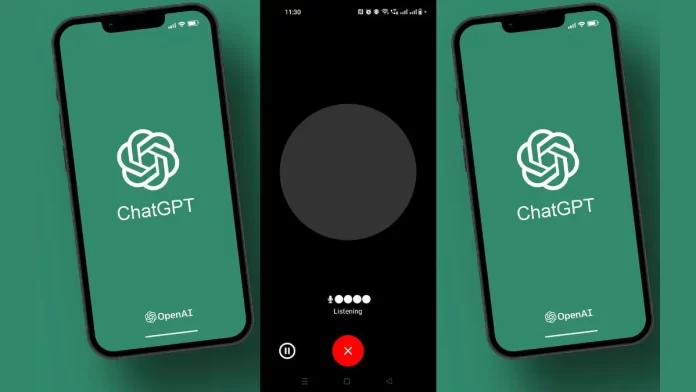ChatGPT exploded onto the scene just a couple of months ago as a sophisticated conversational AI able to understand complex prompts and provide coherent, knowledgeable responses. Up until now, interacting with ChatGPT occurred solely via text, with users typing queries and the bot typing back. But a major update announced this week brings voice capabilities to ChatGPT, allowing genuine back-and-forth conversations with artificial intelligence.
ChatGPT, launched by research company OpenAI in November 2022, showcases remarkable progress in natural language processing. It handles a wide range of topics, admits mistakes, and rejects inappropriate requests all while generating human-like text. ChatGPT’s launch signified a new era for conversational AI.
Now, with the addition of ChatGPT Voice Feature, users can simply speak conversationally with the bot and hear natural-sounding voices respond. This voice interaction brings AI another step closer to feeling human.
ChatGPT Voice Feature Capabilities and Experience
ChatGPT Voice initially provides users with five distinct voice options when enabling the speech function:
Juniper- Confident and reassuring male voice
Sky- Energetic and friendly female voice
Breeze- Soothing female voice
Ember- Compassionate and concerned female voice
Cove- Curious male voice seeking understanding
Each voice sounds impressively human with natural cadence, emphasis, and fluidity. Without visuals, users could easily believe they were speaking with an actual person rather than AI.
The conversational experience itself also feels organic. Questions flow smoothly into answers, tangent topics get explored, and the voices even inject humor and emotion appropriately. Speaking with ChatGPT Voice unlock rich, philosophic discussions impossible via text exchanges.
The Technology Behind ChatGPT Voice
ChatGPT’s effective voice capabilities stem from OpenAI’s custom voice synthesizer called Whisper. This system analyzes tiny voice samples to learn patterns, contexts, tones, and other vocal characteristics. Whisper then generates new unlimited speech matching the original voice while avoiding repetition.
By studying predictive relationships between words, Whisper can make ChatGPT voices converse logically on open topics. The human vocal patterns ensure excellent pronunciation and natural inflection even for long responses.
In fact, OpenAI leverages Whisper for Google Translate-style applications too. For example, Spotify uses Whisper to automatically translate podcast episodes into other languages, retaining the original hosts’ voices.
So while ChatGPT itself handles logic, Whisper voice technology enables the bot to respond out loud natively. Together, the two systems allow smooth back-and-forth conversations between users and AI.
Also Read: How To Use ChatGPT On Azure OpenAI – A Step-by-Step Guide
Benefits of Conversational Voice UI
Enabling voice interactivity with ChatGPT instead of exclusively typing text profoundly impacts the user experience. Conversational voice UIs make complex interactions more natural, personalized and accessible.
More Natural Discussions
There’s an innate humanness to speaking out loud. Voice conversations with ChatGPT feel more casual and comfortable than typed messaging. Users connect better without prose formalities.
Removes Typing Barrier
Voice eliminates typing friction, allowing users to fire off questions spontaneously rather than pausing to type out full sentences. Back-and-forth happens rapidly at a more natural cadence.
Enables Accessibility
Those unable to physically type can still converse with ChatGPT using speech recognition. Voice UIs greatly expand access for many with disabilities.
Useful Hands-Free
Voice makes ChatGPT readily available eyes- and hands-free. People can chat while driving, cooking, walking the dog, etc.
Emotional Connections
Hearing the AI voices triggers stronger emotional resonance in humans. We instinctively inject more feeling, emphasis and warmth when speaking out loud.
In many ways, voice feels like the missing piece that makes conversational AI truly complete. Much like talking to a real human, ChatGPT’s speech capabilities bring tangible benefits over text alone.
Also Read: Top 9 AI Voice Generators
ChatGPT Voice Feature in the Context of OpenAI
ChatGPT Voice’s launch notably overlapped with major leadership upheaval at OpenAI. Both former President Greg Brockman and CEO Sam Altman departed their roles amid board shakeups. However, despite the organizational turmoil, ChatGPT Voice Feature reiterates OpenAI’s technical prowess.
In fact, remaining OpenAI team members explicitly promoted the speech update on social media as proof of their undefeated ability to ship cutting-edge AI innovations. And they aren’t wrong – ChatGPT Voice Feature stands wholly unique among conversational AI platforms today in capabilities.
The voice feature’s expansion also likely previews the rapid evolution timeline still ahead for ChatGPT. OpenAI schedules frequent updates to refine conversational abilities, broaden knowledge areas, and handle more complex prompts. Prior launches added capabilities every few months – so more human-like functions surely await.
Also Read: 23 Creative Ways to Use ChatGPT by OpenAI
The Future Possibilities of AI Voice Tech
ChatGPT Voice Feature represents just the start of a voice technology revolution poised to unfold over coming years across consumer and enterprise AI applications. Beyond improved chatbots, expect voice interfaces to fundamentally transform information search, personal assistants, business analytics and more.
Mainstream Adoption of Voice Assistants
As AI voice tech improves, vocal assistants like Siri and Alexa will transform from basic query bots to conversant advisors tackling complex questions and analysis.
Custom Voices for Branding
Unique branded voices will define future product assistant personalities across major companies and allow personalized advisors for individual users.
Embedded Smart Voice Agents
Specialist conversational AI agents will handle embedded customer service, HR, IT and other business roles to offload repetitive questions.
Voice-Based Immersive Entertainment
Games, movies, and story experiences will all leverage interactive voice AI characters bringing environments alive with spontaneity.
Also Read: The Best Text-to-speech AI Tools for Natural Voice Creation
Conclusion
ChatGPT’s launch already shook industries worldwide by showcasing AI’s language mastery. But enabling conversational voice interaction accelerates the feeling of human-like communication with artificial intelligence even further. Hands-free voice exchanges make using ChatGPT easier, accessible and more relatable.
And ChatGPT itself seems merely the pioneer paving the way for massive voice assistant disruption across consumer and enterprise technology. As AI voice synthesis matures, transformed user experiences await in search, service, analytics and entertainment realms. ChatGPT Voice Feature proves conclusively that the voice tech revolution has arrived – and promises even bigger waves still to come.
If you found our content helpful, please share it on Twitter!
Read More: Top 10 AI Voice Changer Tools for Gamers, Podcasters & More






